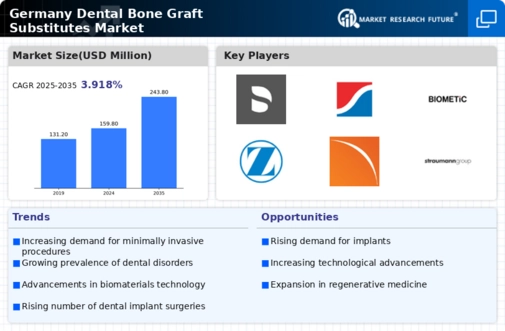Increasing Demand for Dental Implants
The rising prevalence of dental issues in Germany is driving the demand for dental implants, which in turn fuels the growth of the dental bone-graft-substitutes market. As more individuals seek solutions for tooth loss, the need for effective bone-grafting materials becomes critical. According to recent data, the dental implant market in Germany is projected to grow at a CAGR of approximately 7.5% over the next few years. This growth is likely to enhance the demand for bone-graft substitutes, as they are essential for successful implant procedures. The increasing awareness of oral health and advancements in dental technologies further contribute to this trend, indicating a robust future for the dental bone-graft-substitutes market in Germany.
Regulatory Framework Supporting Market Growth
The regulatory environment in Germany plays a pivotal role in shaping the dental bone-graft-substitutes market. Stringent regulations ensure the safety and efficacy of dental products, which can enhance consumer confidence. Recent updates to regulatory guidelines have streamlined the approval process for new bone-graft substitutes, potentially accelerating their entry into the market. This supportive framework encourages manufacturers to innovate and invest in new products, thereby expanding the range of options available to dental professionals. As a result, the dental bone-graft-substitutes market is likely to benefit from a more dynamic and competitive landscape, fostering growth and development in the sector.
Aging Population and Increased Oral Health Awareness
Germany's aging population is a significant driver for the dental bone-graft-substitutes market. As individuals age, they often experience a higher incidence of dental problems, necessitating procedures that require bone-grafting materials. Furthermore, there is a growing awareness of the importance of oral health among the elderly, leading to increased demand for dental treatments. Reports indicate that approximately 30% of the German population is over 60 years old, a demographic that is more likely to seek dental implants and related procedures. This demographic shift is likely to sustain the growth of the dental bone-graft-substitutes market, as more individuals seek solutions to maintain their oral health.
Rising Investment in Dental Research and Development
Investment in dental research and development is crucial for the advancement of the dental bone-graft-substitutes market. In Germany, both public and private sectors are increasingly funding research initiatives aimed at developing innovative bone-grafting materials and techniques. This trend is evidenced by a reported increase of 15% in R&D spending in the dental sector over the last year. Such investments not only foster innovation but also enhance the quality and efficacy of bone-graft substitutes available in the market. As new products emerge, they are likely to meet the evolving needs of dental professionals and patients, thereby propelling the growth of the dental bone-graft-substitutes market.
Technological Advancements in Bone-Grafting Techniques
Innovations in dental technology are significantly impacting the dental bone-graft-substitutes market. The introduction of advanced materials and techniques, such as 3D printing and bioactive scaffolds, enhances the effectiveness of bone-grafting procedures. These advancements not only improve patient outcomes but also reduce recovery times, making them more appealing to both practitioners and patients. In Germany, the integration of digital technologies in dental practices is on the rise, with a reported increase of 20% in the adoption of such technologies over the past year. This trend suggests that the dental bone-graft-substitutes market will continue to evolve, driven by the need for more efficient and effective treatment options.





















Leave a Comment